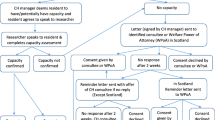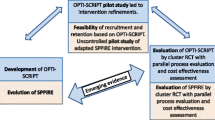Abstract
Background Older people confined to their own homes due to frailty, multiple longterm conditions and/or complex needs, are known to be at risk of medicines-related problems. Whilst a health and social care team approach to supporting these patients is advocated, there is limited evidence regarding how pharmacists can best contribute. Objective To describe a new specialist pharmacy service (called the integrated care clinical pharmacist) in terms of how it works, what it achieves and its policy implications. Setting Patients’ own homes in Lambeth, London, UK. Method Community matrons identified patients who were experiencing medicines related problems. These were referred to the integrated care clinical pharmacist who undertook a full medication review and recorded activities, which were independently analysed anonymously. Main outcome measure Medicines-related problems and the associated interventions. Result 143 patients were referred to the service over a 15-month period. A total of 376 medicines-related problems were identified: 28 (7%) supply issues, 107 (29%) compliance issues, 241 (64%) clinical issues. A diverse range of interventions were instigated by the pharmacist, requiring the coordination of community pharmacists, primary and secondary health and social care professionals. Conclusion This project demonstrated that including an integrated care clinical pharmacy service as part of the health and social care team that visits frail, older people in their own homes has benefits. The service operated as part of a wider inter-professional community team. The service also supported current health policy priorities in medicines optimization by identifying and addressing a wide range of medicines related problems for this vulnerable patient group.
Similar content being viewed by others
References
Gordon K, Smith FJ, Dhillon S. Effective chronic disease management: patients’ perspectives of medication-related problems. Patient Educ Couns. 2007;65:407–15.
Notenboom K, Beers E, van Reit-Nales DA, Egberts TCGE, Leufkens HGM, Jansen PAF, et al. Practical problems with medication use that older people experience: a qualitative study. J Am Geriatr Soc. 2014;62:2339–44.
Pirmohamid M, James S, Meakin S, Green C, Scott AK, Walley TJ, et al. Adverse drug admissions as a cause of admission to hospital: prospective analysis of 18,820 patients. BMJ. 2004;329:15–7.
Howard RL, Avery S, Slavenburg S, Royal S, Pipe G, Lucassen P, et al. Which drugs cause preventable admission to hospital? A systematic review. Brit J Clin Pharmacol. 2006;63:136–47.
DiMatteo R, Giordani P, Lepper H, Croghan T. Patient adherence and medical treatment outcomes: a meta-analysis. Med Care. 2002;40:794–811.
NHS Cumbria: STOPP/START toolkit supporting Medication Review. http://www.cumbria.nhs.uk/ProfessionalZone/MedicinesManagement/Guidelines/StopstartToolkit2011.pdf (2013). Accessed 19 Feb 2017.
Rogers S, Martin G, Rai G. Medicines management support to older people: understanding the context of systems failure. BMJ Open. 2014;4:e005302.
Dhillon AK, Hattingh HL, Stafford A, Hoti K. General practitioners’ perceptions on home medicines reviews: a qualitative analysis. BMC Family Pract. 2015;16:16.
Chen TF. Pharmacist-led home medicines review and residential medication review: the Australian model. Drugs Aging. 2016;33:199.
Cooper JA, Cadogan CA, Patterson SM, Kerse N, Bradley MC, Ryan C, et al. Interventions to improve the appropriate use of polypharmacy in older people: a Cochrane systematic review. BMJ Open. 2015;5:e009235.
Elliot RA, Martinac G, Campbell S, Thorn J, Woodward MC. Pharmacist-led medication review to identify medication-related problems in older people referred to an aged care assessment team: a randomized comparative study. Drugs Aging. 2012;29:593–605.
Boustani M, Campbell N, Munger S, Maidment I, Fox C. Impact of anticholinergics on the aging brain: a review and practical application. Aging Health. 2008;4:311–20.
World Health Organisation: Adherence to long term therapies: evidence for action. http://www.who.int/chp/knowledge/publications/adherence_full_report.pdf (2003). Accessed 22 Sept 2016.
Duerden M, Avery T, Payne R. Polypharmacy and medicines optimization. London: The King’s Fund. 2013.
National Institute for Health and Care Excellence. Medicines optimization: the safe and effective use of medicines to enable the best possible outcomes. NICE guideline [NG5]. London, NICE Medicines and Prescribing Centre. https://www.nice.org.uk/guidance/ng5 (2015). Accessed 22 Sept 2016.
Department of Health. Pharmacy in England: building on strengths, delivering the future. https://www.gov.uk/government/uploads/system/uploads/attachment_data/file/228858/7341.pdf (2008). Accessed 22 Sept 2016.
NHS England: NHS five year forward view. https://www.england.nhs.uk/wp-content/uploads/2014/10/5yfv-web.pdf (2014). Accessed 22 Sept 2016.
SLIC: Southwark and Lambeth integrated care model. http://slicare.org/ (2012). Accessed 21 Sept 2016.
Lai K, Howes K, Butterworth C, Salter M. Lewisham integrated medicines optimization service: delivering a system-wide coordinated care model to support patients in the management of medicines to retain independence in their own home. Eur J Hosp Pharm. 2015;22:98–101.
Dilks S, Emblin K, Nash I, Jefferies S. Pharmacy at home: service for frail older patients demonstrated medicines risk reduction and admission avoidance. Clinical Pharmacist. 2016. https://doi.org/10.1211/CP.2016.20201303.
Acknowledgements
We would like to thank the community matrons who referred patients to this new service and the patients who participated. Guy’s and St. Thomas’ Charity provided 2-year funding for the new service delivery approach, its evaluation and to explore the wider role of community pharmacy (Award Number: GT10040). The funding body did not contribute to the design of the evaluation and data collection, analysis or interpretation of data and did not contribute to the writing of the manuscript.
Funding
None.
Author information
Authors and Affiliations
Corresponding author
Ethics declarations
Conflicts of interest
LO, CL and SQ were involved in service design, delivery and data capture. Whilst listed as authors, they were not involved in the plan and execution of the evaluation or preparation of the final report, from which this manuscript was prepared. This was undertaken independently by SAF and FS.
Rights and permissions
About this article
Cite this article
Oboh, L., Leon, C., Qadir, S. et al. Frail older people with multi-morbidities in primary care: a new integrated care clinical pharmacy service. Int J Clin Pharm 40, 41–47 (2018). https://doi.org/10.1007/s11096-017-0566-8
Received:
Accepted:
Published:
Issue Date:
DOI: https://doi.org/10.1007/s11096-017-0566-8




